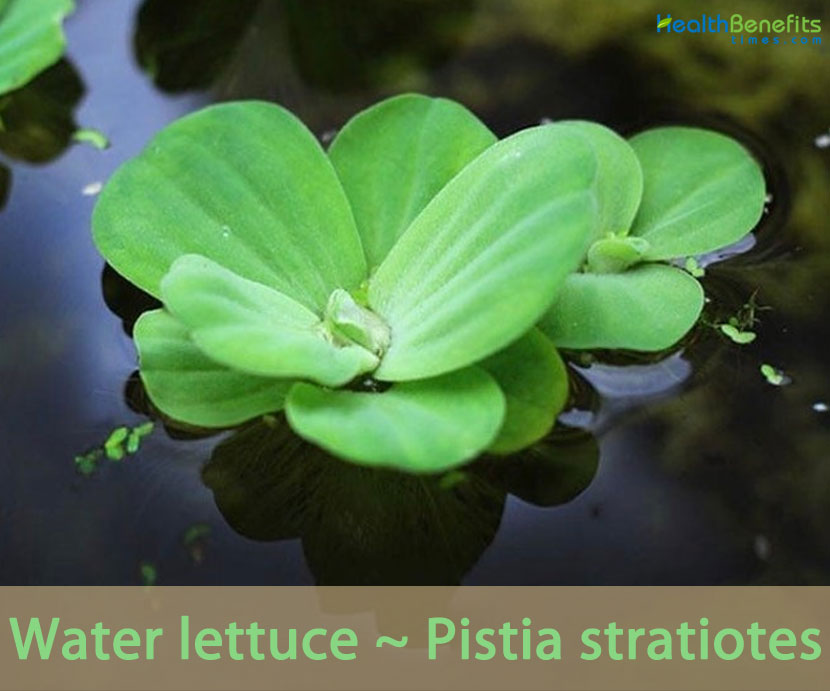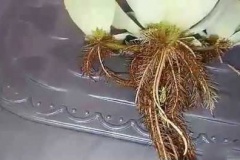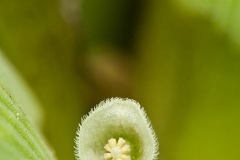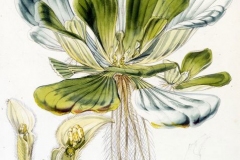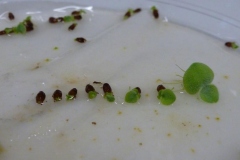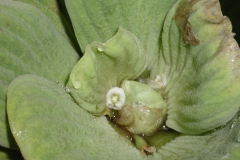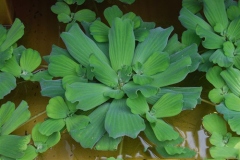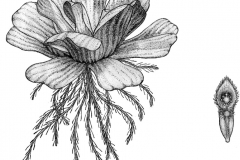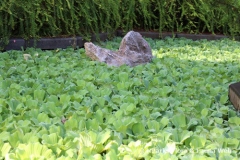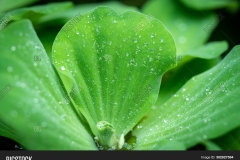| Water lettuce Quick Facts | |
|---|---|
| Name: | Water lettuce |
| Scientific Name: | Pistia stratiotes |
| Origin | South and Central America, Africa and south-east Asia |
| Colors | Green berry that turns brown at maturity |
| Shapes | Egg-shaped or oval berries that are 5-10 mm long and 3-6 mm wide, thin-walled, containing about 4 to 12 seeds |
| Taste | Bitter, pungent |
| Health benefits | Support dropsy, bladder complaints, kidney afflictions, diabetes, hematuria, dysentery, anemia, hemorrhoids, tumors, dysentery, worm infestations, tuberculosis, asthma |
| Name | Water lettuce |
|---|---|
| Scientific Name | Pistia stratiotes |
| Native | South and Central America, Africa and south-east Asia. It is also native to the Northern Territory in Australia. It is found in cooler climates, like Belgium, Czechia, France, Hungary, Italy, the Netherlands, Portugal, Romania, Russia, Slovenia, Spain, Ukraine, and parts of the United States |
| Common Names | Water lettuce, Nile-cabbage, Shellflower, Tropical duckweed, Water-cabbage, Water bonnet, water lily, floating aroid, pistia, water fern |
| Name in Other Languages | Afrikaans: Waterslaai Albanian: Marule uji Amharic: Wiha selat’a (ውሃ ሰላጣ) Arabic: Khas alma (خس الماء), haa ealam alma (حى عالم الماء), zaqim (zuqqym) (زقيم (زُقّيم)، laqimah alqadaa (luqmat alqadaa) (لقمه القاضى (لُقْمَة القاضى), zaqim (زقيم) Armenian: Jri gazar (ջրի գազար) Assamese: Barapuni (বৰপুণি) Azerbaijani: Su kahı Bambara: Kɔbaga Bangladesh: Tokapan Belarusian: Vadzianaja salata (вадзяная салата) Bengali: Jala lēṭusa (জল লেটুস), Ṭōpāpānā (টোপাপানা), Takapana, tokapana Brazil: Alface-d’agua, flor-d’agua, repolho-d’agua Bulgarian: Vodna salata (водна салата), mideno tsvete (мидено цвете) Burmese: Ray s laat (ရေဆလတ်) Cambodia: Chak thom, chal thom Chinese: Shuǐ shēngcài (水生菜), Dà píng (大萍), Dà lián (大蓮), Dà ruǐ píng (大蕊萍), Shuǐ fúróng (水芙蓉), da piao, Shuo he lian, Shuo fu ping, Tian fu ping, Da piao Croatian: Vodena zelena salata Cuba: Lechuga cimarrona Czech: Vodní salát, Babelka řezanovitá Danish: Vand salat, Muslingeblomst, Dominican Republic: Patico Dutch: Watersla, Jantje zwemt, mosselplant, slakroos El Salvador: Verdolaga de agua English: Water lettuce, Nile-cabbage, Shellflower, Tropical duckweed, Water-cabbage, Waterbonnet, waterlily, floating aroid, pistia, water fern Esperanto: Akvo laktuko, Pistio Estonian: Vesisalat Filipino: Litsugas ng tubig Finnish: Vesisalaatti, pistia French: Laitue d’eau, Pistie, Salade du Nil Georgian: Ts’q’lis salati (წყლის სალათი) salati-ts’q’lis salati German: Wassersalat, Muschelblume, Wassersalat Greek: Maroúli neroú (μαρούλι νερού) Gujarati: Pāṇī lēṭīsa (પાણી લેટીસ), Jalashamkhala Hausa: Ruwa letas Hebrew: חסה מים Hindi: Paanee letish (पानी लेटिष), akasathamarai, antharathamra, boranjhanji, jalakumbi, kumbi, choti jala Kumbhi, Jal kumbhi Hungarian: Saláta, Kagylótutaj, úszó kagylótutaj Icelandic: Vatnasalat Indonesian: Selada air, apon-apon, apu-apu, kiapu Irish: Leitís uisce Italian: Lattuga d’acqua, pistia, lattuga acquatica, vela d’acqua Japanese: U~ōtāretasu (ウォーターレタス), Botan’ukikusa (ボタンウキクサ) Javanese: Lettuce banyu Kannada: Nīrina leṭis (ನೀರಿನ ಲೆಟಿಸ್), Kumbik (ಕುಂಬಿಕ್), Anthara gange Kazakh: Cу салаты Korean: Mul sangchu (물 상추) Kurdish: Ava marûzî Lao: Lettuce noa Latin: Aqua lactucis agrestibus Latvian: Udens salāti Lesser Antilles: Chance, godapail Lithuanian: Vandens salotos, Salotinė pistija Macedonian: Zelena salata (зелена салата) Malagasy: Lettuce rano Malay: Salad air, Kiambang Malayalam: Veḷḷaṁ cīra (വെള്ളം ചീര), pisṭiya (പിസ്ടിയ), Kodda pail Malaysia: Kiambang Maltese: Hass tal-ilma Manipuri: Kabokang Marathi: Pāṇī kōśimbirīsāṭhī vāparaṇyāta yēṇārā ēka pālā va tyācē jhāḍa (पाणी कोशिंबिरीसाठी वापरण्यात येणारा एक पाला व त्याचे झाड), Gondala, Jalamandvi, Prasni, sherbala Mongolian: Usny shantsainy urgamal Nepali: Paanee salad (पानी सलाद), Jalakumbhī (जलकुम्भी) Netherlands: Slakroos Norwegian: Vann salat, vass-salat Oriya: ପାଣି ଲେଥୁସ୍ |, ବୋରଝାଞ୍ଜି, Borajhanji Pashto: د اوبو لیټیوس Persian: کاهو آب Polish: Sałata wodna Portuguese: Alface de água, mururé-pajé Punjabi: Pāṇī dī salāda (ਪਾਣੀ ਦੀ ਸਲਾਦ) Romanian: Salata de apa Russian: Vodnyy salat (водный салат), Pistiya (Пистия) Serbian: Vodena zelena salata (водена зелена салата) Sindhi: پاڻي جو ٻلو Sinhala: Vatura salāda koḷa (වතුර සලාද කොළ) Slovak: Vodný šalát Slovenian: Vodna solata South Africa: Waterslaai Spanish: lechuga de agua, Lechuguita de agua, Lechuguilla de Agua, Repollo de Agua, flor de tetumo, lechuguilla, repollo de sapo, verdolago de agua, lamparilla, lechuguilla de vaca, lechuguita de aqua, pasta murure Sudanese: Apu cai Swedish: Vattensallad, Musselblomma Tagalog: Kiyapo Tajik: Salat ob (салат об) Tamil: Taṇṇīr kīrai (தண்ணீர் கீரை), Akasatamari, Agashatamarai, Akayat-tamarai Telugu: Nīṭi pālakūra (నీటి పాలకూర), Pisṭiyā (పిస్టియా), Akasatamara, Antara tamara Thai: N̂ả p̄hạk kād h̄xm (น้ำผักกาดหอม), chok (จอก) jawg Turkish: Su marulu Ukrainian: Vodnyy salat (водний салат) Urdu: Jalakumbhi Uzbek: Suv marul Venezuela: Lechuga de río, repollo de agua Vietnamese: Rau diếp, Bèo cái Welsh: Letys dŵr Zulu: Ulethisi wamanzi |
| Plant Growth Habit | Free-floating, frost-tender, aquatic herbaceous, perennial plant |
| Growing Climates | Rivers, dams, irrigation canals, channels, slow-moving streams in tropical, sub-tropical and warmer temperate regions, drainage ditches, ponds, lakes, springs, surface flow wetlands, reservoirs, polluted water, nearly dried-out lagoons, mud at water’s edge, rice paddies and marshes along the edges of large tropical lakes |
| Soil | Roots of this plant are free-floating, so soil is not necessary for healthy growth |
| Plant Size | Reach a diameter of around 30 cm (12 in) and a height of 10cm (4 in ) |
| Root | Many fibrous roots fibrous, pendulous, measuring up to 50 cm long, with multiple perpendicular rootlets |
| Stem | Floating rosettes produce runners from the leaf bases. These runners are up to 60 cm long and are green, rounded, and quite hairy. They give rise to new rosettes and then readily separate from the parent plant |
| Leaf | Spongy leaves are pale yellowish-green or greyish-green in color. These leaves are 2.5-15 cm long and 2-8 cm wide and are fan-shaped or slightly spoon-shaped and have scalloped margins |
| Flower | Inconspicuous flowers lack petals and arranged on a short column-like flower clusters about 10-20 mm long arising in the leaf forks. These flower clusters have separate male and female flowers. A single female flower, consisting of an ovary and style, is found at the bottom and several (2-8) male flowers, consisting of two stamens, are located at the top |
| Fruit Shape & Size | Egg-shaped or oval berries that are 5-10 mm long and 3-6 mm wide, thin-walled, containing about 4 to 12 seeds |
| Fruit Color | Green berry that turns brown at maturity |
| Seed | Seeds are light brown colored and about 2 mm long and 1 mm wide, ovoid or oblong in shape, have a wrinkled surface, and contain a small air chamber |
| Taste | Bitter, pungent |
| Plant Parts Used | Whole plant, Ash |
| Propagation | By seed and stolons |
| Varieties |
|
Plant Description
Water lettuce is a free-floating, frost-tender, aquatic herbaceous, perennial plant that normally reaches a diameter of around 30 cm (12 in) and a height of 10cm (4 in). It is commonly used as an ornamental plant in water garden. In tropical and sub-tropical climates it is a perennial. In temperate regions the plant behaves as an annual, returning after the winter months from submersed seeds. The plant is found growing in rivers, dams, irrigation canals, channels, slow-moving streams in tropical, sub-tropical and warmer temperate regions, drainage ditches, ponds, lakes, springs, surface flow wetlands, reservoirs, polluted water, nearly dried-out lagoons, mud at water’s edge, rice paddies and marshes along the edges of large tropical lakes.
Roots of this plant are free-floating, so soil is not necessary for healthy growth. The plant has many fibrous roots that are pendulous, measuring up to 50 cm long, with multiple perpendicular rootlets. Feathery roots dangle downward from the plants, providing a shelter for many small fish. As an ornamental plant, water lettuce provides attractive foliage that inhibits growth of algae and helps keep water clear. It is included on the Federal Noxious Weed List. It is also occasionally commonly called shell flower.
Stems
The floating rosettes produce runners (i.e. stolons) from the leaf bases (i.e. axils). These runners are up to 60 cm long and are green, rounded (i.e. terete), and quite hairy (i.e. pubescent). They give rise to new rosettes and then readily separate from the parent plant. Plants resemble small open heads of lettuce. New plants are formed at the ends of stolons radiating outward from the mother plant. Plants can spread rapidly to form dense mats of foliage (to 4” tall), and are considered to be noxious weeds in many tropical and sub-tropical areas where they can quickly cover a pond or lake from shore to shore.
Leaves
The spongy leaves are pale yellowish-green or greyish-green in color. These leaves are 2.5-15 cm long and 2-8 cm wide and are fan-shaped or slightly spoon-shaped (i.e. spathulate) and have scalloped (i.e. crenated) margins. They have 6-15 prominent ribs (i.e. veins) on their undersides and are borne on very short leaf stalks (i.e. petioles). The upper surface is green and tomentose while the lower surface is paler and denser tomentum. These leaves are arranged in an overlapping fashion on a very short stem (i.e. they are densely alternately arranged into a rosette) and are covered in soft, white, velvety hairs (i.e. they are velvety pubescent). The hairs are water repellent and trap air, thus providing buoyancy to the plant.
Flowers
The inconspicuous flowers lack petals and arranged on a short column-like flower clusters about 10-20 mm long arising in the leaf forks (i.e. axils). These flower clusters (i.e. spadices) have separate male and female flowers (i.e. the flowers are unisexual). A single female (i.e. pistillate) flower, consisting of an ovary and style, is found at the bottom and several (2-8) male (i.e. staminate) flowers, consisting of two stamens, are located at the top. At the base of the flower cluster is a whitish colored bract (i.e. spathe) that is 7-12 mm long and about 5 mm wide. There is also a cup-shaped membrane on the column, which separates the male and female flowers from each other. Flowering occurs mostly during summer and early autumn.
Fruits
Fertile flowers are followed by egg-shaped (i.e. ovoid) or oval (i.e. ellipsoid) fruit are greenish colored berries that are 5-10 mm long and 3-6 mm wide, thin-walled, containing about 4 to 12 seeds. The mature seeds are light brown colored and about 2 mm long and 1 mm wide, ovoid or oblong in shape, have a wrinkled (i.e. rugose) surface, and contain a small air chamber. The plant undergoes asexual reproduction by propagating through stolons, yet evidence of sexual reproduction has also been observed in the ponds of Southern Brazil.
Types of Water Lettuce
Listed below are few of the popular varieties of water lettuce
Ruffled Water Lettuce
This variation has leaves that are wavier and does not grow as large or rapidly as other varieties. If you want to put water cabbage into a small container, this is a great choice.
Jurassic Water Lettuce
This is a large variety of water lettuce that can reach the size of a dinner plate. This does not grow at the same speed at the more common varieties.
Splash Water Lettuce
It is a form of water lettuce that stays small and can be difficult to find for your aquarium.
Propagation of Water Lettuce
Water lettuce can propagate both sexually and asexually in the home aquarium, though sexually is extremely rare. However, water lettuce does pardon the pun, breed like rabbits, and you can soon be overrun.
Sexual Propagation
The flower of the water lettuce is situated in the center of the plant with each individual only having male or female flowers. When successful fertilization takes place, a small many-seeded green berry will appear from which new plants will grow.
Asexual Propagation
In this far more common form of propagation, the mother plant will develop smaller daughter plants that are attached to them by short stolons. Mother plants will develop plenty of daughters with little to no help from you.
Be cautious, however, of this kind of propagation as these mother and daughter plants can soon form thick matting over the aquarium’s entire surface. This can result in little or no light reaching any other plants you have in your aquarium, or even cause the suffocation of your fish.
Traditional uses and benefits of Water Lettuce
- Infusion of leaves is used for dropsy, bladder complaints, kidney afflictions, diabetes, hematuria, dysentery, and anemia.
- The plant is used to treat swellings and urinary tract infections.
- Poultice of pounded leaves are used in hemorrhoids, tumors and boils.
- Juice of leaves, mixed with coconut oil, is used for a variety of chronic skin conditions.
- Leaves are mixed with rice and coconut milk, given for dysentery.
- Powdered dry leaves are mixed with a little honey and are used for syphilis, 3 to 4 teaspoons a day.
- Leaves are used for treatment of ringworm of scalp, syphylitic eruptions, skin infections, dysuria, boils and wounds in Indian traditional medicine.
- Oil extract is used for worm infestations, tuberculosis, asthma, dysentery, piles, ulcers and burns.
- It is used for menorrhagia.
- Decoction is added to bathwater to treat edema.
- Water lettuce plant is used as anodyne eyewash in Gambia.
- Leaves are used in eczema, leprosy, ulcers, piles, and syphilis.
- In the Peruvian Amazon, it is used for arthritis.
- Oil extract is used for worm infestations, TB, asthma, dysentery, hemorrhoids, ulcers, syphilitic infections and burns.
- Owing to high potash content, it is used as diuretic and is also used for gonorrhea.
- It is also used in Ayurvedic medicine and for its diuretic, anti-diabetic, anti-dermatophytic, antifungal and antimicrobial properties.
- Dried leaves are prepared into a powder form and are applied to wounds and sores for disinfection in Nigeria.
- Leaf is infused in water to create eyewash to treat allergic conjunctivitis in Nigeria and Gambia.
- Leaves can be burned into ash, and in Indian and Nigerian traditional medicine, the ash is used in treating ringworm infections of the scalp.
- Roots are used externally to treat burns.
- In India, this plant is used as an antiseptic and a treatment for asthma and dysentery.
- Leaves are used in infusion for treatment of abnormal accumulation of liquid s in cellular tissue, bladder complaints, diabetes, and blood in urine, anemia and dysentery.
- Root is used as a laxative, softens inflamed parts and promotes the flow of urine.
- It is used for productive cough and asthma along with rose water and sugar.
- Water lettuce decoction is taken to relieve indigestion, urgency and frequent urination and in baths for reducing hydropsy.
- Leaves decoction is used to relieve difficulty in urination (dysuria)
- Leaves are crushed, warmed and applied externally to treat piles.
- Plant ash is applied externally in headache.
- Plant ash is given along with cow urine to treat goiter.
- Plant juice is used for ear diseases by the tribal people in India called Mundas.
- It is an Ayurvedic medicine used to treat acute and chronic bronchitis, respiratory disorders, all types of cough, nasal congestion, sneezing.
- It is used in the treatment of earache, otorrhea, tinnitus, and other ear disorders.
Culinary Uses
- It is used as a famine food in India in 1877-1878.
- In China, young leaves are eaten cooked.
- Leaves added to soup; prior parboiling advised to remove acridity from calcium oxalate crystals.
- The Hausa people of Nigeria utilized the ash of the plant as a substitute for salt due to its high concentration of potassium chloride, a mineral salt.
- The leaves are sometimes added to soups, but they need to be parboiled first in order to remove the acrid calcium oxalate crystals.
Prevention and Control
Due to the variable regulations around (de)registration of pesticides, your national list of registered pesticides or relevant authority should be consulted to determine which products are legally allowed for use in your country when considering chemical control. Pesticides should always be used in a lawful manner, consistent with the product’s label.
Management of Pistia can be carried out by physical, chemical or biological control or by a combination of these methods (integrated control).
Physical/Mechanical Control
Physical removal of the plants can be done manually or by means of machines. Depending on the size and type of the infested water body different machines can be used. Weeds may be removed from irrigation and drainage canals using standard equipment such as mowing buckets attached to a tractor or a hydraulic excavator, as well as mowing launches. In general Pistia plants will grow in mixed vegetation with rooted plants and by using these machines the total aquatic vegetation will be removed. Special floating harvesters, which first collect the material and subsequently dump it on the shore, may be used in lakes and rivers. However, it should be taken into consideration that, in general, re-colonization of Pistia will occur. This implies that control measures should be part of a long-term maintenance program. Cost effectiveness of the control measures will depend on the losses brought about by Pistia infestation. This will be connected with the economic importance of the water body as well as the indirect effect on health of the local population via water-borne diseases.
Biological Control
Neohydronomus spp. is specialist feeders on P. stratiotes throughout its natural distribution in Central and South America. Confusion over the identity of the Neohydronomus sp. introduced into Australia for biological control was clarified by O’Brien and Wibmer (1989) who recognized three species. Very promising results have been obtained with the weevil Neohydronomus affinis (Hustache) which originated in South America. DeLoach et al. (1976) reported its specificity, and in 1982 it was released in Australia and subsequently in Botswana, Zimbabwe, Benin, Senegal, South Africa, Papua New Guinea and USA (see Harley et al., 1990; ECOWAS, 1995). The insect is well established in these countries, producing relatively high levels of control.
Spodoptera pectinicornis is reported to control P. stratiotes in Thailand and has been screened and recommended for introduction into Florida, USA. A three-pronged attack using the related weevils Argentinorhynchus bruchi, Argentinorhynchus breyeri and Argentinorhynchus squamosus have been successful in controlling the weed’s spread in lab tests in Argentina. Several species of fungus have also been evaluated; Ramularia spp. and Sclerotinia sclerotiorum have shown potential for controlling P. stratiotes populations. See Waterhouse (1994) and Dray and Center (2002) for further information on biocontrol of P. stratiotes.
Chemical Control
Herbicides effective against Pistia include diquat, a combination of diquat and triclopyr, glyphosate, chlorsulfuron, terbutryn, 2, 4-D and endothall.
The application of herbicides in or near water bodies may have serious consequences for the environment. It may also endanger the health of local people if the water is used for drinking, bathing, swimming or washing. These possibilities have to be carefully assessed before the use of herbicides on any but a limited experimental basis. A special formulation of diuron known as AF101 has been recommended in Australia, as well as diquat.
Other Facts
- It is a frequent decorative plant in residential ponds, aquariums and water fountains.
- It is occasionally used for feeding hogs and ducks.
- It is used for making soap in West Tropical Africa.
- Plant is used with soap to removed stains out of clothing.
- Leaves are considered insecticidal.
- It is often used in tropical aquariums to provide cover for fry and small fish.
- It has medicinal properties and can be used as fodder for cattle and pigs.
- Pistia stratiotes acts as a vector for malaria and filariasis.
- Due to high potash value it can be used as green manure for potash deficient soils.
Precautions
- All parts of the plant contain calcium oxalate crystals plus unknown toxins, Ingestion, in large quantities, can cause an intense burning and swelling of the lips, tongue, and throat; nausea and vomiting.
- An overdose may cause acute diarrhea.
References:
https://www.itis.gov/servlet/SingleRpt/SingleRpt?search_topic=TSN&search_value=42542#null
http://www.hear.org/pier/species/pistia_stratiotes.htm
https://www.cabi.org/isc/datasheet/41496
https://gd.eppo.int/taxon/PIIST
http://www.theplantlist.org/tpl1.1/record/kew-156674
https://keyserver.lucidcentral.org/weeds/data/media/Html/pistia_stratiotes.htm
https://nas.er.usgs.gov/queries/greatlakes/FactSheet.aspx?Species_ID=1099
https://en.wikipedia.org/wiki/Pistia
https://plants.usda.gov/home/plantProfile?symbol=PIST2


